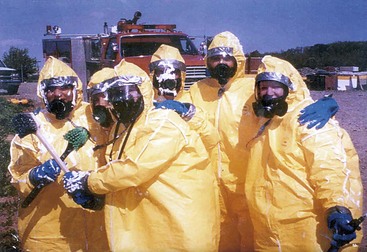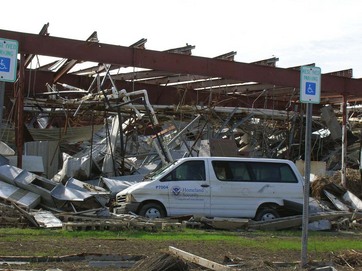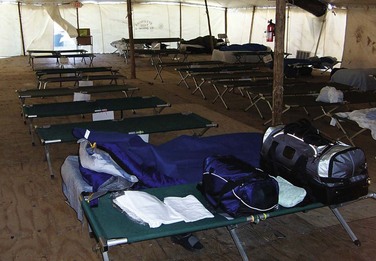Chapter 12 Concepts of Emergency and Disaster Preparedness
Safe and Effective Care Environment
1. Apply principles of triage to prioritize care delivery in a disaster situation.
2. Identify the roles of the nurse in emergency preparedness and response.
3. Compare the key personnel roles in an emergency preparedness and response plan.
4. Describe the components of an emergency preparedness and response plan.
5. Develop a personal emergency preparedness plan.
6. Identify the type of patients to recommend for hospital discharge in a disaster situation.
http://evolve.elsevier.com/Iggy/
Answer Key for NCLEX Examination Challenges and Decision-Making Challenges
Review Questions for the NCLEX® Examination
Types of Disasters
Both internal and external disasters can result in many casualties, including death. Multi-casualty and mass casualty (disaster) events are not the same. The main difference is based on the scope and scale of the incident, considering the number and severity of victims or casualties involved. Both require specific response plans to activate necessary resources. In general, a multi-casualty event can be managed by a hospital using local resources; a mass casualty event overwhelms local medical capabilities and may require the collaboration of multiple agencies and health care facilities to handle the crisis (Smith, 2010). State, regional, and/or national resources may be needed to support the areas affected by the event. Trauma centers have a special role in all emergency preparedness activities because they provide a critical level of expertise in complex injury management.
To maintain ongoing disaster preparedness, hospital personnel participate in emergency training and drills regularly. In the United States, The Joint Commission (2008) mandates that hospitals have an emergency preparedness plan that is tested through drills or actual participation in a real event at least twice yearly. One of the drills or events must involve community-wide resources and an influx of actual or simulated patients to assess the ability of collaborative efforts and command structures. In addition, accredited health care organizations are required to take an “all-hazards approach” to disaster planning. Using this approach, preparedness activities must address all credible threats to the community that could result in a disaster situation. Disaster drills, then, are ideally planned based on a risk assessment that identifies the events most likely to occur in a particular community. For example, a flood is more likely in the Gulf of Mexico and an avalanche is more likely in ski areas of the Rocky Mountains.
An evacuation plan is also part of fire prevention and preparedness plans for health care facilities. The Life Safety Code® published by the National Fire Protection Association provides guidelines for building construction, design, maintenance, and evacuation. Every health care facility is required to practice at least one fire drill or actual fire response once a year. Patient evacuation is not required if the event is a drill. All facility personnel are mandated to have training on fire prevention and responsiveness each year. Chart 12-1 lists general guidelines for fire responsiveness and building evacuation to ensure safety.
Chart 12-1 Best Practice for Patient Safety & Quality Care
Nurse’s Role in Responding to Health Care Facility Fires
• Remove any patient or staff from immediate danger of the fire or smoke.
• Discontinue oxygen for all patients who can breathe without it.
• For patients on life support, maintain their respiratory status manually until removed from the fire area.
• Direct ambulatory patients to walk to a safe location.
• If possible, ask ambulatory patients to help push wheelchair patients out of danger.
• Move bedridden patients from the fire area in bed, by stretcher, or in a wheelchair; if needed, have one or two staff members move patients on blankets or carry them.
• After everyone is out of danger, seek to contain the fire by closing doors and windows and using an ABC extinguisher (can put out any type of fire), if possible.
• Do not risk injury to you or staff members while moving patients or attempting to extinguish the fire.
Impact of Recent External Disasters
The term “NBC” was coined to describe nuclear, biologic, and chemical threats. In response, emergency medical services (EMS) agencies and hospitals upgraded their decontamination facilities, equipment, and all levels of personal protective gear to better protect staff. ED physician and nursing staff underwent hazardous materials (HAZMAT) training and learned how to recognize patterns of illness in patients who present for treatment that potentially indicate biologic terrorism agents, such as anthrax or smallpox (Fig. 12-1). Protocols for the pharmacologic treatment of infectious disease agents, as well as stockpiles of antibiotics and nerve agent antidotes, were made readily available.
In 2005, Hurricane Katrina made landfall in Louisiana and other Gulf states as a category-4 storm and caused more than 1000 deaths and devastating environmental and property damage (Fig. 12-2). Volunteers from all over the United States, as well as local, regional, and federal agencies, took part in the large-scale disaster evacuation, rescue, and relief effort that severely challenged available resources and established disaster plans. Critical systems failed and were eventually re-established through coordination with multiple agencies and people to ensure that the most basic human needs were met (Fig. 12-3). Hurricane Katrina overwhelmed the existing emergency care system and caused the mobilization of a national mutual aid response on a level that had not been experienced in recent U.S. history.
Common to all mass casualty events, the desired outcome of emergency preparedness is to outline ways to meet the extraordinary need for hospital beds, staff, drugs, personal protective equipment (PPE), supplies, and medical devices, such as mechanical ventilators (Casani & Romanosky, 2006). The U.S. government stockpiles critical equipment and supplies in case they are needed for a pandemic influenza outbreak. In addition, the Food and Drug Administration (FDA) approved the first vaccine to protect humans against H5N1 avian influenza virus (see Chapter 25 for more information on emerging infections). Each state has its own specific emergency preparedness plan for pandemic influenza, including who would receive vaccines in a mass casualty event. Most of these plans are posted on the Internet.
Emergency Preparedness and Response
Mass Casualty Triage
Triage Process
Action Alert
In mass casualty or disaster situations, implement a military form of triage with the overall desired outcome of doing the greatest good for the greatest number of people (Smith, 2010). This means that patients who are critically ill or injured and might otherwise receive attempted resuscitation during usual operations may be triaged into an “expectant” or “black-tagged” category and allowed to die or not be treated until others received care.
Triage functions may be performed by EMS providers in the field, such as:
• Emergency medical technicians (EMTs) and paramedics
• Nurse and physician field teams who are called from the hospital to a disaster scene to assist EMS providers
• Nurse and physician hospital teams to assess and reassess incoming patients
Before going to the incident in the field, nurses, physicians, and support staff must have adequate training to prepare them to recognize the risks in an unstable environment (Laskowski-Jones, 2010). Such risks can include the potential for structural collapse, becoming the secondary target of a terrorist attack, interpersonal violence in unsecured locales, and working in an environment in which contagious diseases and natural hazards are common (e.g., poisonous snake bites and mosquito-borne illnesses). Disaster workers must take measures such as obtaining prophylactic medications and vaccinations, having a personal evacuation plan, and ensuring access to necessary supplies and protective equipment so that they do not become victims as well.
The National Disaster Life Support Foundation offers Basic Disaster Life Support and Advanced Disaster Life Support training courses that include all essential aspects of disaster response and management. They include the core competencies of disaster management to all levels of health care professionals (Subbarao et al., 2008). In addition, the Federal Emergency Management Agency (FEMA) provides Community Emergency Response Team (CERT) training so that people are better prepared for disasters and are able to respond more self-sufficiently to incidents and hazard situations in their own communities. These courses include mass casualty triage education.
Triage Method
An important point to recognize is that triage concepts in a mass casualty incident differ from the “civilian triage” methods discussed in Chapter 10 that are practiced during usual emergency department operations (Table 12-1). Although disaster triage practices can vary widely based on local EMS protocols, some concepts are fairly universal. Most mass casualty response teams both in the field (at the disaster site) and in the hospital setting use a disaster triage tag system that categorizes triage priority by color and number (Smith, 2010):
• Emergent (class I) patients are identified with a red tag.
• Patients who can wait a short time for care (class II) are marked with a yellow tag.
• Nonurgent or “walking wounded” (class III) patients are given a green tag.
• Patients who are expected to die or are dead are issued a black tag (class IV).
TABLE 12-1 COMPARISON OF TRIAGE UNDER USUAL VERSUS MASS CASUALTY CONDITIONS
| TRIAGE UNDER USUAL CONDITIONS | TRIAGE UNDER MASS CASUALTY CONDITIONS |
|---|---|
| Emergent (immediate threat to life) | Emergent or class I (red tag) (immediate threat to life) |
| Urgent (major injuries that require immediate treatment) | Urgent or class II (yellow tag) (major injuries that require treatment) |
| Nonurgent (minor injuries that do not require immediate treatment) | Nonurgent or class III (green tag) (minor injuries that do not require immediate treatment) |
| Does not apply | Expectant or class IV (black tag) (expected and allowed to die) |
Physiological Integrity
A. Young woman with closed fractures of her right leg and arm
B. Older woman with abdominal bleeding who is dazed and confused
C. Middle-aged man with third-degree burns over 90% of his body
D. Young man with numerous bruises and superficial lacerations
Stay updated, free articles. Join our Telegram channel

Full access? Get Clinical Tree





